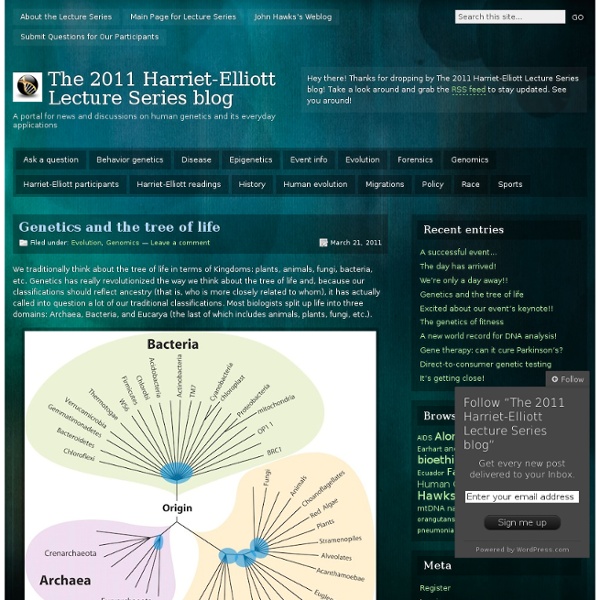Genetics and the tree of life

History of Life by Jesse Brunner on Prezi
Biomedical science funding
We support research into all aspects of biomedical science: from molecules and cells vital to life, through the spread of diseases or the vectors of disease across the globe, to clinical and public health research to improve the quality of healthcare. Research can be based in the laboratory, the clinic or the field, and may involve experimental or theoretical approaches. We do not just fund scientists - through our biomedical science grants we support undergraduate and doctoral students, clinicians, dentists and veterinarians. We fund the best researchers with the most innovative and exciting ideas in the form of personal and research support, collaborations and support for symposia, conferences and workshops. A significant proportion of our funding is devoted to support those working overseas. About biomedical science We support molecular, cellular and structural biology, as well as clinical, physiological, psychological, epidemiological and public health research. Our funding schemes
Time to call out the anti-GMO conspiracy theory
Mark Lynas speech hosted by the International Programs – College of Agriculture and Life Sciences (50th Anniversary Celebration) , and the Atkinson Center for a Sustainable Future, Cornell University 29 April 2013, 2.15pm ET I think the controversy over GMOs represents one of the greatest science communications failures of the past half-century. This matters enormously because these technologies – in particular the various uses of molecular biology to enhance plant breeding potential – are clearly some of our most important tools for addressing food security and future environmental change. I am a historian, and history surely offers us, from witch trials to eugenics, numerous examples of how when public misunderstanding and superstition becomes widespread on an issue, irrational policymaking is the inevitable consequence, and great damage is done to peoples’ lives as a result. This is what has happened with the GMOs food scare in Europe, Africa and many other parts of the world.
The History of Life on Earth by Robert Patierno on Prezi
thisviewoflife
Agriculture
Cell Size and Scale
Some cells are visible to the unaided eye The smallest objects that the unaided human eye can see are about 0.1 mm long. That means that under the right conditions, you might be able to see an ameoba proteus, a human egg, and a paramecium without using magnification. A magnifying glass can help you to see them more clearly, but they will still look tiny. Smaller cells are easily visible under a light microscope. It's even possible to make out structures within the cell, such as the nucleus, mitochondria and chloroplasts. To see anything smaller than 500 nm, you will need an electron microscope. Adenine The label on the nucleotide is not quite accurate. How can an X chromosome be nearly as big as the head of the sperm cell? No, this isn't a mistake. The X chromosome is shown here in a condensed state, as it would appear in a cell that's going through mitosis. A chromosome is made up of genetic material (one long piece of DNA) wrapped around structural support proteins (histones). Carbon
The 2011 Harriet-Elliott Lecture Series blog
Related:
Related:



